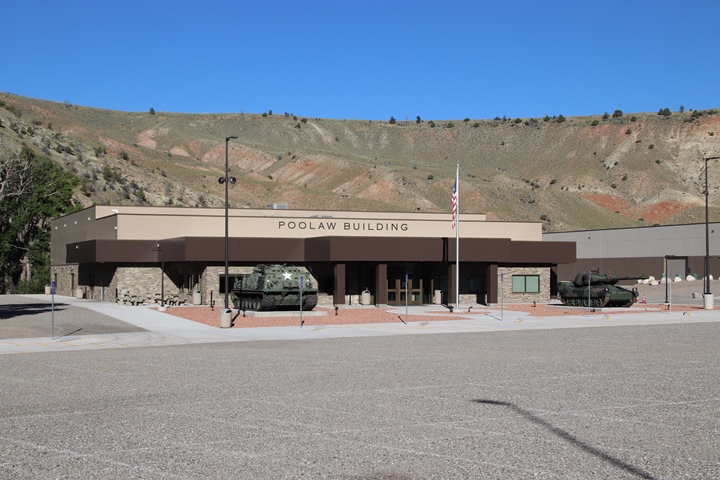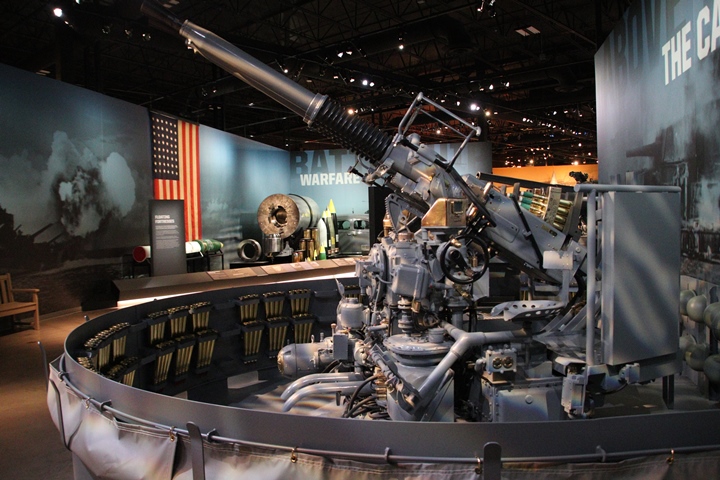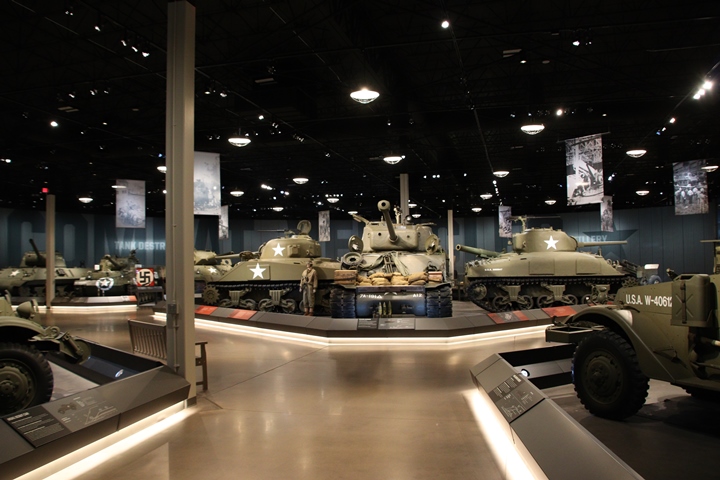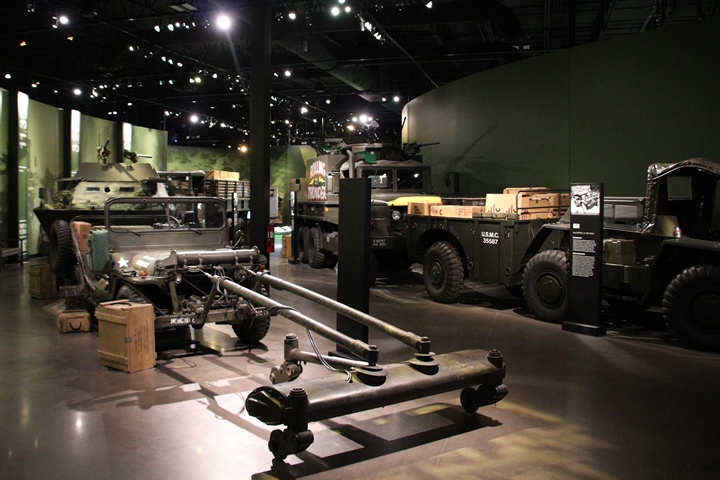|
The National Museum of Military Vehicles
Dubois, WY
An American Automobile Industry in World War Two Special Report
This page added 8-24-2023.
Two things motivated me to author this special
report on the National Museum of Military Vehicles. Firstly, it
has the largest collection of World War Two military vehicles built by
American automobile and truck manufacturers that I have documented on
other pages of this website. This is an excellent museum to see
these vehicles all in one place. Secondly, the sheer size for the
museum and its fully equipped restoration shop sets it apart from any
other military vehicle museum in the United States.
There are vehicles built to help win World War
Two by the American automobile companies, including American Bantam Car
Company, Buick Division of General Motors, Chevrolet Division of General
Motors, Chrysler Corporation, Dodge Truck, Fisher Body Division of
General Motors, Ford Motor Car Company, GMC Division of General Motors,
GM of Canada, Studebaker, and Willys-Overland. Beyond these
automotive vehicle manufacturers, the museum also has vehicles produced
by farm implement, locomotive, truck, and trailer manufacturers,
including Allis-Chalmers, American Car and Foundry, American LaFrance,
Autocar, Baldwin Locomotive Works, Brockway Motor Company, Caterpillar
Tractor Company, Cleaver-Brooks Company, Converto Manufacturing Company,
Corbitt Company, Diamond T Motor Car Company, J.I. Case Company,
International Harvester Corporation, Hercules Body Company, Hyde
Corporation, Mack Truck, Marmon-Herrington Company, Oshkosh Motor Truck
Corporation, Pacific Car and Foundry Company, Pressed Steel Car Company,
Ward-LaFrance Truck Corporation, and White Motor Company.
There are also several LVT-4s in the museum's
collection. There are no data plates on these vehicles to identify
which of the following companies produced them. Those companies
were: Food Machinery Corporation, Graham-Paige Motors Corporation, and
St. Louis Car Company.

This is the main entrance to the museum.

From the area of the main gate, this image
shows the main museum building.

The Veterans Pavilion is west of the main
building.

The Poolaw Building contains a cafe and
meeting rooms. The cafe is an excellent idea, as the museum is
twelve miles from town. For those who are at the museum at lunch
time, it is just a short walk over to the cafe.
The building is named after Pascal C. Poolaw,
Sr., a member of the Kiowa Tribe, who served in World War Two, Korea,
and Vietnam. He was awarded 42 medals and citations during his
service, making him the most decorated Native American in United States
military history.

If there is a power failure at the museum,
it has two Cummins-built standby generators to keep the lights on and
the museum operating. This is impressive and shows some of the
extensive preplanning that went into the construction of the museum.

Inside the Museum: Next are a few
selected photos that give the essence of what the museum is all about.
With the large number of vehicles and displays in the museum,
it is nearly impossible to show everything
in an article like this. The best thing to do is visit the museum
and see all of it for one's self.

This is obviously not a military vehicle.
It is a U.S. Navy twin 40mm Bofors anti-aircraft gun that was used
extensively aboard American ships during World War Two. However,
even more importantly, this weapon is in the Doris Miller Annex of the
museum. Doris Miller, pictured here, was awarded the Navy Cross
for his bravery and duty during the attack on Pearl Harbor on December
7, 1941. Cook Doris Miller was the first African-American awarded
this medal in the history of the U.S. Navy. While he is best known
for manning a .50 caliber machine gun and possibly shooting down a
Japanese Imperial Navy aircraft that was attacking his ship, he was also
most instrumental in moving wounded sailors to safer areas on his ship,
the USS West Virginia.
While the museum is about vehicles, it has not
forgotten the human side of the story.

I have never seen a World War Two 40mm
Bofors gun tub restored with such detail as this one at the National
Museum of Military Vehicles. This is an example of the
thoroughness with which the museum makes each display as original as
possible.

All of the rubber hoses are installed and
the brass fittings on the gun mount are not painted over, as they are on
other museum displays. This is just an outstanding restoration and
display piece.

This photo was taken at the entrance to the
main World War Two armor exhibit. The Sherman tank in the center
is an M4A3(76) HVSS built by the Fisher Body tank plant in Grand Blanc,
MI in October 1944. It is serial number 62966.
To the left of it is a Sherman tank
M4E9(75)VVSS built by the American Locomotive Company in April 1943.
It is serial number 1788.
To the right is a Pressed Steel Car
Company-built M4A1(75)VVSS. This was built for the war effort in
October 1943.
Inside this main armor exhibition hall is a
row of armored cars, light tanks, and scout cars. There is also a
section of anti-tank weapons, both motorized and towed. Behind the
tanks in center is a row of artillery pieces. On the right side of
the World War Two armor hall is a row of half-tracks.
Note there are no roped barriers to interfere
with taking photos or just looking at the vehicles. The
information placards and intrusion barriers are all mounted at foot
level. This is a really nice touch to have the best possible
experience while visiting.

Within the armor exhibition hall is this impressive collection of World
War Two artillery. This section exhibits (from left to right) an
8-inch howitzer, a 155mm gun, a 155mm howitzer, a 105mm howitzer, and a
75mm pack howitzer.

Trucks were extremely important to the
winning of World War Two. These trucks are part of the museum's
Red Ball Express display. Included in this display are trucks
manufactured by Autocar, Dodge Truck, GMC Division of General Motors,
Corbitt Company, Diamond T Motor Car Company, Mack Truck, Studebaker,
and White Motor Company.

Seeing this was just about worth the trip
out to Dubois, WY. This is the only Brockway Motor Company bridge
erecting truck I have ever seen. My timing was right for my visit,
as this was only put on display several months before my arrival.

The museum also has more World War Two era
vehicles located in battle themed displays. This one shows both
American and German vehicles used in the battle.

The museum is home the world's largest
collection of Japanese World War Two artillery. This is part of
that display.

This is a Japanese 47mm anti-tank gun.
These were used with great effectiveness against American tanks,
especially the Sherman. Historical photos of the battles on
Tarawa, Iwo Jima, and Okinawa, to name a few, in many cases show Sherman
tanks with holes punched through the armor plate. This was a very
effective weapon.

This portion of the Korean War display shows
this International Harvester M-5-6 6x6 2-1/2 ton truck at the Chosen
Reservoir.
The museum's Vietnam War display is the
largest I have ever seen and is second to none. Most museums treat
the Vietnam War as an afterthought. Not at the National Museum of
Military Vehicles. Its size and breadth rival the World War Two
displays within the museum.

All Vietnam displays include a Huey
helicopter, as does the National Museum of Military Vehicles.

If one was coming of age in the late 1960's,
then one learned about the war on the CBS News with Walter Cronkite at
6:30 in the evening. We had a 19-inch Motorola black and white
table model that I watched the news on each evening. I probably
watched the episode showing on the TV set in this display. No, we
did not have shag carpet nor modernistic furniture in our house.

Truck convoys were used extensively to
supply the troops in the field. The museum has examples of typical
vehicles used for this purpose. In the foreground is a P170 mine
detector. This is the only one I have ever seen. I was
unaware that they existed until I visited this museum.

This is a Tet diorama.
Outside Displays:
Not all of the museum's vehicles are on
display inside the main museum. Many are on display at the outside
pavilion.

There are three M3 Stuart tanks along with a
dozen half-tracks located on the west side of the pavilion. Under
the roof of the pavilion, there are another forty vehicles.

Being the world's largest collection of
military vehicles and continually growing means that some vehicles end
up outside in the weather. This very rare Autocar U8144T is only
one of three known to exist in the United States. It is the only
one that is part of a museum and the only one I have ever seen in ten
years of working on this project. It would be hoped that this and
many of the other vehicles located along the Wind River will be brought
under cover in the future.
This Autocar U8144T would fit well into the
World War Two Red Ball display. There are two Autocar U7144Ts on
display in that section. One could be exchanged for this vehicle
after a restoration.

This and the next photo show the vehicles
that are on outside display along the Wind River.

The National Museum of Military Vehicle's
Restoration Shop: During my visit, I was able to visit the
museum's restoration shop in downtown Dubois. Just like the museum
and its collection of vehicles, the restoration shop is in a league of
its own. Other military museums contract out their restorations.
Not the National Museum of Military Vehicles. I am not sure
whether I was more impressed with the museum or its restoration shop.
Both are first class operations.

This view is looking west at the facility.
The offices are on the far left. Next, to the right, behind the
first two garage doors are the machine and welding shops. There
are also two bays in this area for working on vehicles. The high
bay building in the center is where all of the heavy duty restoration of
vehicles takes place. The large building on the right end of the
photo are the spare parts warehouse and paint shop. The far door
at the right end of the building is the entrance to the paint shop.

The high bay restoration portion of the
building is equipped with a 20-ton overhead crane for engine and
transmission pulls.

This Fisher Body-built M4A2 is being
completely torn down for restoration. When complete, it will be
one of the museum's road worthy vehicles used for parades in Dubois.

This is the machine shop.

This is the weld shop.

When I was told there was a warehouse
attached to the restoration shop, I was not expecting something this
large. Once again, this shows the preplanning that went into the
design of this building.

There is even a UH-60 in the warehouse.

This image shows the restoration shop,
warehouse, and paint shop early in the morning. The town of
Dubois, where it is located, is in a valley with the Wind River running
through it.

To the east of the restoration shop is this
apartment building that is under construction. Actually, this is
being constructed by the owner of the museum after he determined there
was not enough housing in Dubois.
The main museum building east of Dubois, which
encloses over 3.5 acres of inside display area, opened in August 2020.
Thus began the National Museum of Military Vehicles as an added tourist
draw for the area. In 2022, 46,000 persons visited the museum.
Many were on their way to other attractions in the area, such as
Yellowstone National Park which is 105 miles northwest of town.
Others, like myself, came to Dubois specifically to visit the museum.
Many of the persons visiting the museum ate or stayed in Dubois on their
trip, adding to the revenue of local businesses.
The museum itself generated construction jobs
between 2017 and 2022 when the museum was being built. The museum
itself employees local citizens in its normal day-to-day operations
along with those employed in the Poolaw Building cafe and the
restoration area in Dubois. Museum management also noted the need
for more affordable housing in the Dubois area and has initiated the
construction of an apartment complex. The museum is more than just
a museum to the local residents and businesses. It is an added
source of economic growth in this scenic town in the Wyoming Rocky
Mountains.
|

































